Abstract
Background:
Few Indian studies have deliberated on the role of personality traits in perceived stress and burnout among female nurses employed in the government sector.
Materials and Methods:
A cross-sectional questionnaire-based survey was conducted among 600 female nurses employed in 30 government hospitals of India. Two hundred and ninety-eight valid questionnaires received with demographic data, NEO Five-Factor Inventory scores, Perceived Stress Scale-10, and Copenhagen Burnout Inventory scores were analyzed using linear regression analysis.
Results:
Trait neuroticism scores had modest positive correlation for personal burnout (R2: 0.32, F: 138.68), work-related burnout (R2: 0.22, F: 84.09), and overall burnout scores (R2: 0.30, F: 128.09). Extraversion scores had low negative correlation with personal burnout (R2: 0.08, F: 27.22, P < 0.00), work-related burnout (R2: 0.09, F: 28.81), and overall burnout scores (R2: 0.10, F: 31.68). Scores on agreeableness trait had weak negative correlation with personal burnout (R2: 0.09, F: 32.98), workrelated burnout (R2: 0.06, F: 20.96), patientrelated burnout (R2: 0.06, F: 21.27), and overall burnout scores (R2: 0.10, F: 33.43). Openness to experience had no significant correlation to personal, work-related, patient-related, or overall burnout scores. Conscientiousness scores had low negative correlation with the scores on personal burnout (R2: 0.12, F: 41.96), work-related burnout (R2: 0.09, F: 27.88), and overall burnout scores (R2: 0.10, F: 31.80). Neuroticism had modest positive correlation with perceived stress scores (R2: 0.33, F: 145.61). Extraversion, agreeableness, and conscientiousness were weakly negatively correlated with perceived stress scores.
Conclusions:
Trait neuroticism increased the vulnerability to perceived stress and burnout, whereas traits of extraversion, conscientiousness, and agreeableness were protective against perceived stress and burnout in the sample of female nurses surveyed.
Keywords: Burnout, female nurses, five factors, perceived stress, personality
Nursing professionals begin careers with an intent to care and help others.[1] The psychological costs of caring and other administrative tasks exact a toll on their physical and mental health. This state of excessive and prolonged stress in health-care professionals leading to burnout has been documented since 1974. The American psychoanalyst Herbert Freudenberger proposed this term to describe a state of emotional exhaustion among people working in human service and health care.[2] The International Classification of Diseases, 10th Edition of the WHO classified this “state of vital exhaustion (Z73.0)” under problems related to life management difficulty.
Christina Maslach classified burnout into three categories: (a) emotional exhaustion as “tired and fatigued feeling that develops as emotional energies are drained,” (b) depersonalization describes “The negative attitude that people may display towards their colleagues,” and (c) personal accomplishment reflects “the feeling of competence and successful achievements in one's working with people.”[3] Burnout among nurses has been reported mostly in the Maslachian paradigm in numerous studies done in the western world.
Environment, contextual factors, and occupational hazards were the areas of research initially and only in the past two decades, researchers have focused on the role of employee factors, especially the role of personality factors in the development of burnout among nurses. Personality is defined as “constant set of intrapsychic or internal characteristics and predisposition that directly determine psychological behaviour.”[4] Personality influences the way an individual interacts and deals with the world and copes with stressful situations. Personality accounted for a significant portion of variance in burnout scores even when other situational variables were accounted in a longitudinal analysis of burnout in health-care setting.[5]
Layman and Guyden suggested that introverted people were at higher risks of developing burnout than extraverted people.[6] Ghorpade et al. in a cross-sectional survey of 265 full-time university teachers found that emotional exhaustion is negatively related to extraversion and emotional stability and positively related to openness to experience.[7] Magnano et al. in a cross-study of 144 helping profession workers reported that extraversion, agreeableness, and conscientiousness did not predict any burnout factor. Emotional stability and openness to experience predicted burnout factors.[8] Ang et al. surveyed nurses in a tertiary care hospital in Singapore and noted that staff nurses <30 years of age with high to very high neuroticism were more likely to experience emotional exhaustion, high depersonalization, and low personal accomplishment.[9]
The results of studies exploring the relationship between personality and burnout variables have been difficult to interpret and compare due to the different tools to measure personality used by the various researchers. It is necessary to know about the determinants of burnout to develop interventions to modify person-related variables and to screen for vulnerable individuals in an organization. To our knowledge, no multicentric studies in India have addressed the relationship of personality traits and its relation to burnout in female working nurses.
MATERIALS AND METHODS
Approval to conduct the study was obtained from the institutional ethics committee of the hospital. Six hundred female nurses in 30 government hospitals of India were approached through mail. The participation was voluntary and anonymous. The participants completed a response sheet containing sociodemographic questionnaire, Copenhagen Burnout Inventory (CBI), Perceived Stress Scale-10 (PSS-10), and NEO Five-Factor Inventory (NEO FFI) and mailed it back to the researcher.
The 60-item NEO FFI by McCrae and Costa is a well-validated personality assessment tool based on the current universal accepted five-factor theory of personality.[10] It measures five domains of personality – neuroticism, extraversion, openness, agreeableness, and conscientiousness.
CBI is a public domain questionnaire developed by the National Institute of Occupational Health Denmark. It differentiates three forms of burnout which were defined according to the life domains from which they may arise. (a) Personal burnout measures the degree of physical and psychological exhaustion experienced by the person regardless of the occupational status, (b) work-related burnout: measuring the degree of physical and psychological exhaustion which is perceived by the person as related to work, and (c) client- or patient-related burnout: measuring the degree of physical and psychological exhaustion which is perceived by the persons as related to work with patients. The scale has 19 items with five response categories. The responses are rescaled to a 0–100 metric. Scale scores are calculated by taking the mean of the items in the scale.[11]
PSS-10: This is a 10-item brief self-report questionnaire that measures person's evaluation of the stressfulness of the situations in the past month of their lives. PSS measures the degree to which situations in one's life are appraised as stressful.[12]
The inclusion criteria were female nurses in government hospitals with at least 1 year of service. Nurses who were unwilling for the survey and those with a history of psychiatric treatment or follow-up were excluded from the study.
RESULTS
Three hundred and forty-two questionnaires were received. Thirty-nine response sheets were incomplete and five nurses admitted being under psychiatric care and were excluded from the study. The data pertaining to the final sample of 298 nurses were analyzed.
The final sample consisted of nurses across all age groups (24.8% of participants were between 21 and 30 years of age, 23.5% of participants were between 31 and 40 years of age, 41.9% of participants were between 41 and 50 years of age, and 9.4% of participants were between 51 and 60 years of age). The participant's mean experience in government service was 16.9 ± 9.3 years. Married nurses constituted 75.5% of the sample.
Mean PSS score of the sample was 15.98 ± 6.22 (mean + standard deviation) and 144 nurses (48.32% of the sample) had scores above 17.
The percentage of nurses scoring above 50 in various domains of personal burnout, work-related burnout, patient-related burnout, and overall mean burnout scores were 27.2%, 14.7%, 9.4%, and 12.4%, respectively.
The scatter plots for the various scores on personality traits in NEO FFI and the mean overall burnout scores in CBI are depicted in Figures 1-5 and their regression analysis with ANOVA is shown in Table 1. A modest positive correlation was noted between neuroticism trait score and all types of burnout scores. Weak negative correlation was noted between extraversion, agreeableness and conscientiousness and personal, work- and patient-related Burnout [Table 1]. Correlation coefficients between PSS-10 scores and five factors of personality of NEO FFI are shown in Table 2. Trait neuroticism had modest positive correlation with perceived stress and extraversion, agreeableness, and conscientiousness were weakly negatively correlated.
Figure 1.
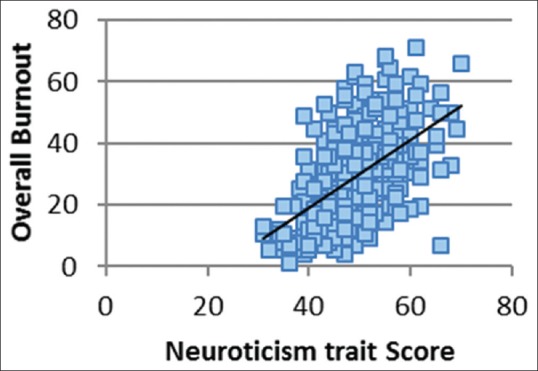
Overall burnout scores versus neuroticism trait scores
Figure 5.
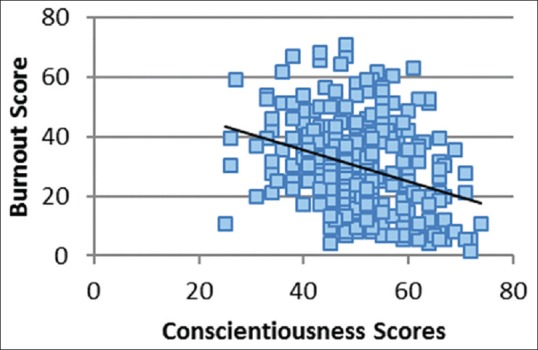
Overall burnout scores versus conscientiousness trait scores
Table 1.
Regression analysis and ANOVA of Personality trait factors and various Types of Burnout
| Personality factors | Personal related Burnout |
Work related Burnout |
Patient related Burnout |
Overall Burnout |
||||||||
|---|---|---|---|---|---|---|---|---|---|---|---|---|
| r | r2 | F statistic (significance) | r | r2 | F statistic (significance) | r | r2 | F statistic (significance) | r | r2 | F statistic (significance) | |
| Neuroticism | 0.56 | 0.32 | 138.68(*) | 0.47 | 0.22 | 84.09(*) | 0.38 | 0.15 | 526.75(*) | 0.55 | 0.30 | 128.09(*) |
| Extraversion | 0.29 | 0.08 | 27.22(*) | 0.30 | 0.09 | 28.81(*) | 0.2 | 0.04 | 544.24(*) | 0.31 | 0.09 | 31.68(*) |
| Openness | 0.02 | 0.00 | 0.11(NS) | 0.08 | 0.00 | 2.13(NS) | 0.03 | 0.00 | 0.19(NS) | 0.06 | 0.00 | 0.91(NS) |
| Agreeableness | 0.32 | 0.09 | 32.98(*) | 0.26 | 0.06 | 20.96(*) | 0.26 | 0.06 | 21.27(*) | 0.32 | 0.10 | 33.43(*) |
| Conscientiousness | 0.35 | 0.12 | 41.96(*) | 0.29 | 0.08 | 27.88(*) | 0.16 | 0.03 | 546.23(*) | 0.31 | 0.09 | 31.80(*) |
Data obtained from 298 female nurses and linear regression analysis done. r - regression coefficient, F - F Statistic, P – significance, *P<0.001, NS: P>0.05
Table 2.
Regression analysis and ANOVA of Personality traits and Perceived Stress Scores
| Personality factors | Perceived stress scores correlation coefficients |
|||
|---|---|---|---|---|
| r | r2 | F statstic | significance | |
| Neuroticism | 0.57 | 0.33 | 145.61 | * |
| Extraversion | 0.29 | 0.08 | 27.87 | * |
| Openness | 0.06 | 0.003 | 2913.99 | NS |
| Agreeableness | 0.30 | 0.09 | 1462.66 | * |
| Conscientiousness | 0.27 | 0.07 | 23.64 | * |
Data obtained from 298 female nurses and linear regression analysis done. r - regression coefficient, F - F Statistic, P – significance, *P<0.001, NS:P>0.05
Figure 2.
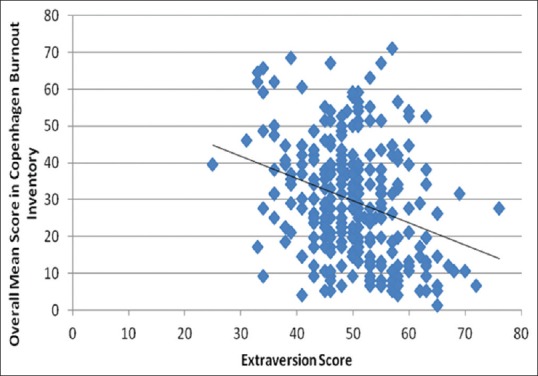
Overall burnout scores versus extraversion trait scores
Figure 3.
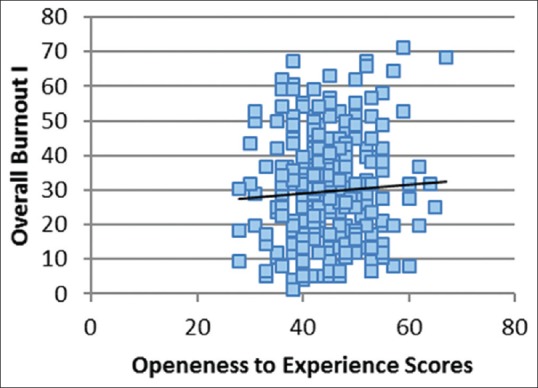
Overall burnout scores versus openness to experience trait scores
Figure 4.
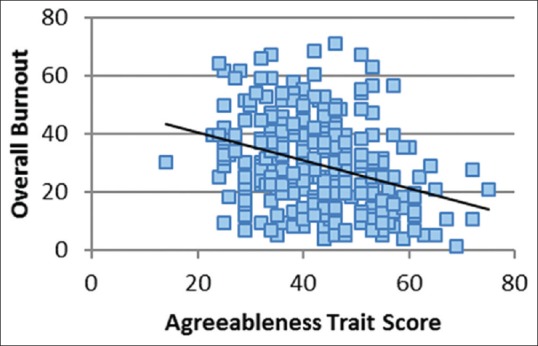
Overall burnout scores versus agreeableness trait scores
DISCUSSION
The purpose of the study was to find the relationship between various personality traits and perceived stress and personality traits and the various types of burnout. The strength of this study is that the participants spanned all age groups and all specialties from 30 hospitals of a wide geographic region in India.
The five-factor model is the most popular method in modern personality psychology research and enables the researchers to compare their results.
Trait neuroticism scores have a modest relationship with perceived stress and all domains of burnout. This was consistent with that of most of the researchers including Shimizutani et al. and Zellars et al.[13,14] Costa and Mc Crae had described neuroticism as the most pervasive domain of personality. These people are prone to a variety of psychological distress and development of a variety of psychiatric disorders. They are characterized by irrational thinking low self-esteem, poor control of impulses, and ineffective coping resulting in recurrent nervous tension, depression, frustration, guilt, and self-consciousness.
Extraverts tend to be with positive emotions, higher frequency, and intensity of personal interactions, optimistic, and reappraise problems in a positive manner. Extraversion traits confer an advantage for nursing and administrative jobs where higher levels of uncertainty recur in the workflow as reported by Moutafi et al.[15] They tend to focus on the good and positive side of the experiences and this temperament enables them in reaching decisions with team members. Subjective well-being and higher job satisfaction have been correlated to extraversion in meta-analysis.[16] These could explain the negative correlation of trait extraversion scores with all types of burnout and perceived stress found by us.
Our study revealed a negative correlation of agreeableness trait score and all domains of burnout and perceived stress scores. High scores on agreeableness trait may encompass the stereotype of the ideal nurse, as altruism, nurturance, and caring characterize this trait. These people are more likely to be treated kindly by others and evoke a favorable response from the work environment. Higher job satisfaction has been reported in individuals with these traits.[16]
Deary et al. had reported that nurses with more open personalities were more likely to be emotionally exhausted.[17] However, in our study, the correlation between openness to experience and various domains and perceived stress was very weak and not significant. Among the Big Five personality traits, openness to experience is the least predictive in meta-analyses for its correlation with job satisfaction and burnout.[16]
Conscientiousness is associated with self-discipline, achievement, striving, dutifulness, and competence. They tend to be traditional in outlook, organized, and responsible. In our study, we found a negative correlation between this trait score and various domains of Burnout and consistent with that reported by Piedmont and Deary et al.[5,17]
CONCLUSIONS
In this multicentric study sample of 298 female nurses, we found that trait Neuroticism increased the vulnerability to Perceived stress and Burnout, whereas traits of Extraversion, Conscientiousness and Agreeableness were protective against Perceived Stress and Burnout.
The limitations of our study were its cross sectional nature and the possibility of healthy workers completing the questionnaires and that the nurses could have answered randomly to the various questionnaires and self report measures.
Financial support and sponsorship
Nil.
Conflicts of interest
There are no conflicts of interest.
REFERENCES
- 1.Eley D, Eley R, Bertello M, Rogers-Clark C. Why did I become a nurse? Personality traits and reasons for entering nursing. J Adv Nurs. 2012;68:1546–55. doi: 10.1111/j.1365-2648.2012.05955.x. [DOI] [PubMed] [Google Scholar]
- 2.Freudenberger HJ. Staff burnout. J Soc Issues. 1974;30:159–65. [Google Scholar]
- 3.Maslach C, Jackson SF, Leiter MP. Maslach Burnout Inventory Manual. 3rd ed. Palo Alto, CA: Consulting Psychologists Press; 1996. [Google Scholar]
- 4.Maddi S. Personality Theories: A Comparative Analysis. California: Brooks/Cole; 1989. [Google Scholar]
- 5.Piedmont RL. A longitudinal analysis of burnout in the health care setting: The role of personal dispositions. J Pers Assess. 1993;61:457–73. doi: 10.1207/s15327752jpa6103_3. [DOI] [PubMed] [Google Scholar]
- 6.Layman E, Guyden JA. Reducing your risk of burnout. Health Care Superv. 1997;15:57–69. [PubMed] [Google Scholar]
- 7.Ghorpade J, Lackritz J, Singh G. Burnout and personality: Evidence from academia. J Career Assess. 2007;15:240–56. [Google Scholar]
- 8.Magnano P, Paolillo A, Barranao C. Relationships between Personality and Burnout: An empirical study with helping professions workers. Int J Hum Soc Sci Res. 2015;1:10–9. [Google Scholar]
- 9.Ang SY, Dhaliwal SS, Ayre TC, Uthaman T, Fong KY, Tien CE, et al. Demographics and personality factors associated with burnout among nurses in a Singapore tertiary hospital. Biomed Res Int. 2016;2016:6960184. doi: 10.1155/2016/6960184. [DOI] [PMC free article] [PubMed] [Google Scholar]
- 10.McCrae RR, Costa PT., Jr Personality trait structure as a human universal. Am Psychol. 1997;52:509–16. doi: 10.1037//0003-066x.52.5.509. [DOI] [PubMed] [Google Scholar]
- 11.Kristensen TS, Borritz M, Villadsen E, Christensen KB. The Copenhagen burnout Inventory: A new tool for the assessment of burnout. Work Stress. 2005;19:192–207. [Google Scholar]
- 12.Cohen S, Kamarck T, Mermelstein R. A global measure of perceived stress. J Health Soc Behav. 1983;24:385–96. [PubMed] [Google Scholar]
- 13.Shimizutani M, Odagiri Y, Ohya Y, Shimomitsu T, Kristensen TS, Maruta T, et al. Relationship of nurse burnout with personality characteristics and coping behaviors. Ind Health. 2008;46:326–35. doi: 10.2486/indhealth.46.326. [DOI] [PubMed] [Google Scholar]
- 14.Zellars KL, Perrewe PL, Hochwarter WA. Burnout in healthcare: The role of five factors of personality. J Appl Soc Psychol. 2000;30:1570–98. [Google Scholar]
- 15.Moutafi J, Furnham A, Crump J. Is managerial level related to personality. Br J Manag. 2007;18:272–80. [Google Scholar]
- 16.Judge TA, Heller D, Mount MK. Five-factor model of personality and job satisfaction: A meta-analysis. J Appl Psychol. 2002;87:530–41. doi: 10.1037/0021-9010.87.3.530. [DOI] [PubMed] [Google Scholar]
- 17.Deary IJ, Watson R, Hogston R. A longitudinal cohort study of burnout and attrition in nursing students. J Adv Nurs. 2003;43:71–81. doi: 10.1046/j.1365-2648.2003.02674.x. [DOI] [PubMed] [Google Scholar]


